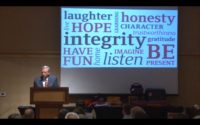
Structural engineering leader was cited by ENR in 2001 for driving the success of the ACE Mentor program.
Image: ENR
Charles H. Thornton Jr., 83, a 60-year industry innovator in structural engineering and education, died on Dec. 12 at his home in Easton, Md., following a brief illness, said Thornton Tomasetti LLC, the design firm he co-founded and led as chairman and CEO. He was instrumental in "often taking on technically challenging projects that others said couldn’t be done," the company said, including leading design of two of the world's first supertall structures—Petronas Towers in Malaysia and Taipei 101 in Taiwan—while also steering the ACE Mentor Program of America he launched to connect thousands of students and industry professionals in driving next-generation workforce growth.
That foresight earned Thornton, known as "Charlie," ENR's Award of Excellence in 2001.
“Charlie was a visionary, foreseeing the needs of structural engineering, our clients, the building industry and the public it serves,” said Richard Tomasetti, the firm's co-founder and Thornton's long-time colleague.
"There is a handful of structural engineers who have had a profound impact on the profession over the last 100 years," said Ron Klemencic, chairman and CEO of Magnusson Klemencic Associates. "Charlie Thornton was clearly among that small number. He was immensely talented and fiercely competitive, inspiring many, including me. One of his greatest legacies is the ACE Mentor program which has positively impacted countless numbers of next-generation engineers."
'Revolutionary'
The New York City native, the son of a bricklayer and city building inspector, began his career in 1960 as an engineer at Lev Zetlin Associates, already holding advanced engineering degrees from New York University and completing a thesis on cable nets.
"The first projects we worked on together were the American Airlines hangars in San Francisco and Los Angeles," said Tomasetti, noting use of light-gauge, hyperbolic paraboloid steel as the primary structural element to build the 235-ft-long hangars economically. "It was revolutionary," he said.
Thornton and Tomasetti bought the firm in 1977, growing its multidisciplinary expertise worldwide. "Charlie ... said we should always hire people who are smarter than us," said Tomasetti. The company expanded its design portfolio from specialized and long-span structures to high-rise buildings, airports, sports and entertainment venues and transportation hubs, with forensic engineering expertise as well.
Thornton was also a recognized expert in collapse and structural failure analysis, leading the investigation of 1978 collapses of the Hartford, Conn., coliseum roof and of a West Virginia coal power plant cooling tower under construction that killed 51 workers. He also was on the FEMA team that probed the 1995 Alfred P. Murrah federal building terror blast in Oklahoma City.
Firm staff members were the first engineers on site after the Sept. 11, 2001, terror attack on the World Trade Center in lower Manhattan to advise on structural issues affecting rescue, demolition and cleanup for the next nine months.
Having an Impact
Thornton Tomasetti ranks at No. 67 on ENR's Top 500 Design Firms list, reporting more than $340 million in 2022 architectural and engineering revenue.
Thornton's "substantial impact on his profession and the world is reflected in the work of the successful company he helped build, the silhouettes of the prominent structures he helped design and the careers of the talented colleagues he helped mentor," said William Nugent, president and CEO of forensic engineer Wiss, Janney, Elstner Associates.
During more than 40 years leading the firm, Thornton always enjoyed the competition of a project pursuit as well as moving engineering and construction technology forward. His push to solve industry challenges did not end with his retirement from Thornton Tomasetti in 2004.
That year, Thornton co-founded TGE Top Down, a firm that uses a building approach he helped develop decades before for a top-down construction system, with floors built on the ground and raised into place around a tall building concrete core. The company completed a 10-story, 621,000-sq-ft office building in Bangalore, India, using the method in 2018, with work set to start early next year on its first U.S. project, a residential tower in Denver.
"Charlie was amazing to watch work, he had a background in aerospace, and was the most brilliant structural designer I have ever met," said TGE Top Down partner Dan Esparza. "I recall him saying 'I want my buildings to be strong and stable but light enough that they could fly.'" Thornton's ability to think differently and model and understand structures set him apart as an engineer and project team leader, but he also fiercely defended the method from critics, even when competitors used it, Esparza said.
Thornton "was my mentor, business partner and ally, but most importantly my friend," he added.
ACE Mentor Reaches Out
Thornton's zeal for sharing his expertise broadly started even before he left Thornton Tomasetti, with his 1990s founding of the ACE Mentor program as a way to develop needed construction career interest among high school students—particularly those from demographic groups and communities long under-represented—by expanding their interactions with industry professionals on and off the job site.
“What I started to realize is that you can’t sell engineering to high school students, you’ve got to go in and sell an industry. You’ve got to talk about architecture, construction, engineering, subcontracting, steel erection, the trades, and get these kids excited," Thornton said in a 2011 TV interview.
“The program has produced over 100,000 graduates so far,” said Stephanie McNeely, ACE Mentor director of development and strategic partnerships, with 4,100 industrial professionals serving as mentors in 36 states, Puerto Rico and Toronto. About 10,000 students in 1,500 high schools participate annually, with over 70% who are people of color and about 40% women.
To date, the program has also awarded $32.4 million in scholarships to participants.
“We did an internal evaluation recently, and estimate that 2,000 people who participated in ACE enter the construction industry every year,” said Diana Eidenshink, its president and Thornton’s daughter. “It became something bigger than he ever envisioned, beyond his wildest dreams.”
Alan Traugott, a principal at Advanced Resource Consulting and a former senior vice president at Flack + Kurtz, terms Thornton "a force of nature" in his push to expand ACE participation. "I remember vividly how quickly he came to me and asked 'when are we starting a Pittsburgh chapter?' and we did almost immediately," he said. "We really didn't have a farm system, there was a great need for this kind of mentorship at the high school level."
Recognition of Thornton's career achievements includes Induction into the National Academy of Engineering and National Academy of Construction, honorary memberships in the American Institute of Architects and American Society of Civil Engineers, and many other awards.
Thornton's 2014 memoir, "A Life of Elegant Solutions” shared its name with his sailboat and his outlook, former colleagues said.
“Live life elegantly or make it elegant,” both Esparza and Tomasetti noted he would often say.
According to the company, in lieu of flowers, donations may be made to the ACE Mentor Program Charles H. Thornton Memorial Scholarship Fund.







Post a comment to this article
Report Abusive Comment